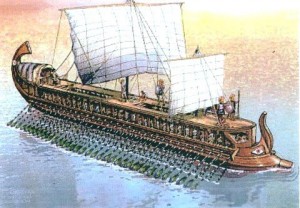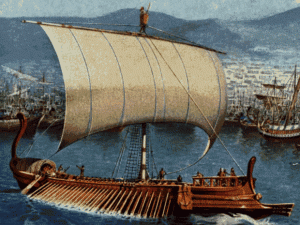Ancient Greece was mountainous and almost every place in Greece was close to the sea. As a result, traveling by sea using sea vehicles (Ancient Greek Ships) started very early on in the region of Greek. People used boats to catch fish, for trading as well as for wars. The ancient Greeks became master sailors due to the frequent use of boats for travel.

Why were boats so important to ancient Greeks?
Due to the Geography of Ancient Greece, the cities were mostly close to the seas and they preferred waterways rather than land routes for transportation and trade. So boats, ships, and sailing became a very important part of ancient Greek life. They used boats and ships for a number of reasons. Fishing was a good source of income, for trade, for conquering other territories and even for piracy boats and ships were used.
Types of Ancient Greek Ships
These were namely the military ship, the cargo ship along with these two were the small crafts. While the military, as well as the cargo ships, were of great importance, the small crafts were only used for the purpose of transport of just a few people. Though initially, the ships in ancient Greece were very basic or elementary yet with the passage of time the Greeks made substantial improvements which made the ships travel faster ultimately resulting in making the Greeks powerful sailors.

Beginning with the Greek warships, these were initially long, narrow and single level ships. These ships were basically used for transfer troops to the sight of the battles and hence they were designed in such a manner so as to reach the destination as quickly as possible.
Ancient Greek Fishing Boats
In ancient Greece, there were different boats for different uses. The shapes and sizes differ as per the use. They used small rowboats for fishing, large ships for trading and fast warships called Trireme for wars. The Greeks built their ships from the outside in.
They first built the hull and then the inside portions of the ship. When there was no or less wind the Greeks used wooden oars while in windy conditions they used a single square sail made of linen cloth.

Earlier versions of warships
There was no leading ship type until 800 BC. The earliest shops were mainly used to carry troops and marine battles were rare. The Penteconter was the first specialized war galley during the archaic period. It consisted of 25 oars on both sides and had a length UP TO of 38 meters. It could muster a speed of about 10 knots. This type of ship is even mentioned in writings of Homer about the Trojan war.
Bireme was another warship galley that came into development around 700 BC. It could be around 80 feet long and had two sets of oars. They were even used by Romans to great effect.
Greek Trireme Model
The large warships called Trireme had three banks of oars. These ships needed as many as 170 people to operate the oars and were almost 120 feet long. The ships were made out of cedar, pine or fir and were lighter than they looked.
Only the hull of the ships was made using oak. These ships had long and narrow decks which the soldiers used for fights.The ancient Greeks would generally not sail far away from land as back then there were no tools to know directions and they feared getting lost in the sea.
Trireme was a development of the earlier used Pentekontors which consisted of 25 oarsmen on each side and the bireme, which was another warship which consisted of two branches of oars. One of the most prominent warships to be used during this time was called the Trireme which came to be extensively used around 500BC. This trireme was extremely rapid and reached up to 14 knots under good weather conditions. The trireme was 118 feet in length, 18 feet wide and 8.5 feet tall. As many as 170 oarsmen propelled this warship.
It was developed around the 6th and 7th centuries and was mastered by the Athenians. It was almost 30 to 50 meters long. It was a brilliant ship of the era where it could travel almost 350 km. It offered a great advantage in speed and maneuverability.
However, only 14 soldiers could be carried in one trireme at one time as by then ships were mainly used in naval battles rather than for transporting troops. In spite of all these advantages, this trireme suffered from one major drawback which was that because these Ancient Greek Boats were light, it could very easily be blown off due to high winds. Another difficulty of this type of ship was it required a very drilled crew which took a lot of time making it quite costly to maintain and also difficult to replace the crewmen if they are killed in battle.

Ships in war
The ships or navy were mainly used for the siege of naval ports which disrupted trade resulting in an economic loss for the enemy forces. There was also blockading of essential trade routes to cause trade disruption of trade and commerce. Another effective way to use naval force was to pour in troops in strategic locations which were demonstrated by Athens in the initial phases of the Peloponnesian war. It resulted in a surprise factor and attack at the weak points.
In headlong battles, the most common strategy was to ram the protruding front of the ship into its sides to rip it apart from the middle. Another way was to anchor the enemy ships to its own and connect them so that troops could pour in and kill enemy crew.
Ancient Greek Trade Ships
Such were the ships built by the ancient Greeks and used for different purposes mainly trading and warfare.
Immediately after the warships, the cargo or trade ships were of utmost importance. These ships were mainly used for the purpose of import and export. Hence, the prosperity of ancient Greece could be attributed to these ships. The traders went all the way from Greece to Egypt, Italy, and even Spain.
The major advantages of these cargo ships were that they required comparatively lesser time to reach if compared to travel by road. Additionally, due to the complicated mountainous terrain, it was the water transport which was most favored by the people.

Since these ships had to travel into the winds, they usually sailed in the zigzag pattern. In the beginning around 40BC, these ships weighed around 150 tons. However, by 240BC, the weight of these ships increased to somewhere between 350-500 tons.
Navigation was crucial to a sailors survival. Hence, every man was expected to not only know the basic intricacies involved in boating and sailing but also to master them in order to be assured of his safe arrival to his destination.
How did the ships sail
Deficiencies
Ancient Greek sailing was greatly limited by technological deficiencies and preferred to keep sight of land until absolutely necessary to go away from lands as compasses were still not invented. It was the Romans who came to use Astrolabes which made sailing much easier.